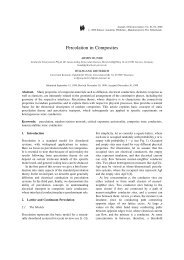Emplacement depths and radiometric ages of Paleozoic plutons of ...
Emplacement depths and radiometric ages of Paleozoic plutons of ...
Emplacement depths and radiometric ages of Paleozoic plutons of ...
You also want an ePaper? Increase the reach of your titles
YUMPU automatically turns print PDFs into web optimized ePapers that Google loves.
230<br />
Several <strong>plutons</strong>, predominantly <strong>of</strong> granitic composition,<br />
intruded into or adjacent to the WBSZ <strong>and</strong><br />
CBSZ, parts <strong>of</strong> them synkinematically (Scheuvens,<br />
1999; Zulauf et al., 2002). Lower Carboniferous<br />
emplacement <strong>ages</strong>, ranging from ca. 330 to 350 Ma,<br />
have been determined for these intrusions by U–Pb<br />
<strong>and</strong> Pb–Pb zircon dating (e.g., Bor pluton, Mutěnín<br />
pluton, Babylon granite, Drahotín gabbro, Klatovy<br />
pluton, Ny´rsko pluton; Dörr et al., 1997; Central<br />
Bohemian pluton; Holub et al., 1997). Only the<br />
Teufelsberg (Čertu˚v kámen) diorite yields an Upper<br />
Devonian age (see below).<br />
In contrast to the TBU, the Moldanubian unit is<br />
characterized by widespread Carboniferous granitoids<br />
<strong>and</strong> anatexis, the age <strong>of</strong> which has recently been<br />
determined at 322–326 Ma (U–Pb on zircon <strong>and</strong><br />
titanite, 40 Ar– 39 Ar on hornblende, Kalt et al., 2000).<br />
Lower grade mica schists <strong>and</strong> gneisses are restricted to<br />
the Královsky Hvozd crystalline complex, a Moldanubian<br />
subunit situated SE <strong>of</strong> the NKM (Fig. 1). In<br />
this area, metapelitic rocks partly contain kyanite<br />
relics <strong>of</strong> an early medium pressure metamorphism<br />
(Vejnar, 1991; Babu˚rek, 1995), suggesting a multistage<br />
metamorphic evolution within parts <strong>of</strong> the<br />
Moldanubian unit. The age <strong>of</strong> this medium pressure<br />
metamorphism (i.e., Cadomian or Variscan) has yet<br />
not been determined. However, microspores preserved<br />
within low grade metamorphic mica schists near<br />
Rittsteig suggest a <strong>Paleozoic</strong> protolith for at least<br />
parts <strong>of</strong> the Královsky Hvozd metasediments (Reitz,<br />
1992). Apart from these mica schists, the Moldanubian<br />
unit adjacent to the study area consists <strong>of</strong> a<br />
prograde succession <strong>of</strong> <strong>and</strong>alusite-bearing mica<br />
schists, cordierite sillimanite gneisses, <strong>and</strong> cordierite<br />
K-feldspar anatexites (Blümel, 1990).<br />
3. Methods<br />
The composition, emplacement depth, cooling history,<br />
<strong>and</strong> tectonometamorphic overprints <strong>of</strong> granodiorite,<br />
diorite, <strong>and</strong> gabbro <strong>of</strong> the Vsˇepadly, Smrzˇovice,<br />
Orlovice, Vsˇeruby, Neukirchen, Teufelsberg, <strong>and</strong><br />
Hoher–Bogen–Rittsteig areas have been investigated<br />
(for localities, see encircled numbers 1–8 in Fig. 1).<br />
In the case <strong>of</strong> the Teufelsberg pluton, we also determined<br />
the protolith age. Geobarometric <strong>and</strong> geothermometric<br />
data were derived from the chemical<br />
C. Bues et al. / Tectonophysics 352 (2002) 225–243<br />
compositions <strong>of</strong> olivine, pyroxene, amphibole, biotite,<br />
<strong>and</strong> feldspar, which were analysed at the Technische<br />
Universität Darmstadt <strong>and</strong> the Universität Würzburg<br />
using a Cameca SX-50 electron microprobe. The<br />
operating conditions were similar to those reported<br />
in Bues <strong>and</strong> Zulauf (2000). Summaries <strong>of</strong> representative<br />
mineral analyses are listed in Table 1. The mineral<br />
abbreviations used throughout the text are according<br />
to Kretz (1983).<br />
We applied the geothermometer <strong>of</strong> Blundy <strong>and</strong><br />
Holl<strong>and</strong> (1990) <strong>and</strong> Holl<strong>and</strong> <strong>and</strong> Blundy (1994) to<br />
calculate equilibration temperatures <strong>of</strong> hornblende <strong>and</strong><br />
plagioclase for the Vsˇepadly granodiorite <strong>and</strong> Smrzˇovice<br />
quartz diorite. These rocks also contain the<br />
appropriate buffer assemblage required for the Al-in-<br />
Hbl barometry according to Schmidt (1991) <strong>and</strong><br />
Anderson <strong>and</strong> Smith (1995). Equilibration temperatures<br />
<strong>of</strong> orthopyroxene <strong>and</strong> clinopyroxene were calculated<br />
for the Smrzˇovice, Vsˇeruby, <strong>and</strong> Teufelsberg<br />
pyroxene diorite using the TWQ program <strong>of</strong> Berman<br />
(1991) together with the revised thermodynamic database<br />
<strong>of</strong> Berman et al. (1995) <strong>and</strong> Berman <strong>and</strong> Aranovich<br />
(1996). This method was also applied to the<br />
Opx–Cpx–Spl corona <strong>of</strong> the olivine metagabbro <strong>of</strong><br />
the eastern Hoher–Bogen area. For the Vsˇeruby<br />
olivine gabbro <strong>and</strong> gabbronorite, we additionally used<br />
the Opx–Cpx geothermometer <strong>of</strong> Wells (1977).<br />
To carry out K–Ar analyses <strong>of</strong> hornblende <strong>and</strong><br />
biotite, mineral separation was performed in the<br />
laboratory <strong>of</strong> the geological institute <strong>of</strong> the AVČR<br />
(Prague) using st<strong>and</strong>ard techniques, such as crushing,<br />
sieving, flotation, Frantz magnetic separation, <strong>and</strong><br />
h<strong>and</strong> picking. K–Ar analyses were carried out in the<br />
laboratory <strong>of</strong> the Bundesanstalt für Geowissenschaften<br />
und Rohst<strong>of</strong>fe (BGR, Hannover) using flame<br />
photometry <strong>and</strong> noble-gas mass spectrometry for<br />
K–Ar determination. Details <strong>of</strong> sample processing<br />
are given by Kreuzer et al. (1989). All errors quoted<br />
were calculated on the 95% (2r) confidence level.<br />
Zircons <strong>of</strong> the Teufelsberg pluton (locality<br />
‘Hoher–Stein’) have been separated <strong>and</strong> abraded<br />
(for the separation <strong>and</strong> analytical techniques, see also<br />
Dörr et al., this volume). Dissolution <strong>and</strong> separation <strong>of</strong><br />
U <strong>and</strong> Pb were carried out after Krogh (1973). Each<br />
single zircon was placed in a Teflon vessel within an<br />
autoclave <strong>and</strong> digested over 6 days at 180 jC with 24<br />
N HF. After cooling, a mixed 235 U– 208 Pb spike was<br />
added to one-third <strong>of</strong> the solution <strong>of</strong> the zircon to



